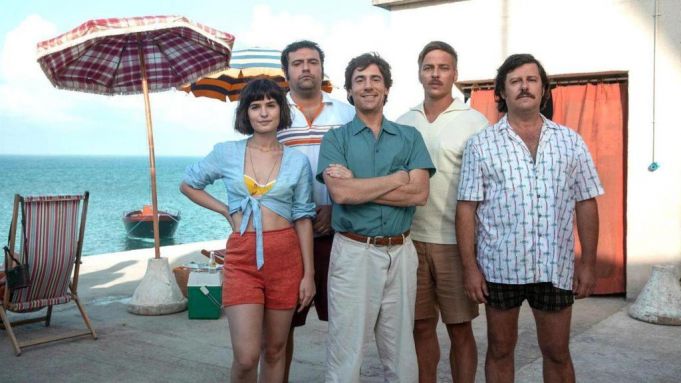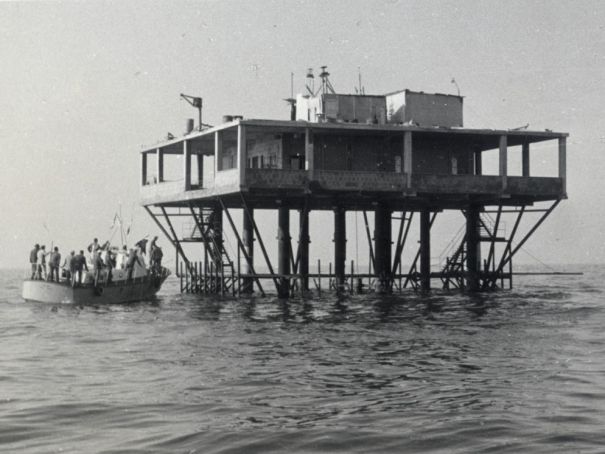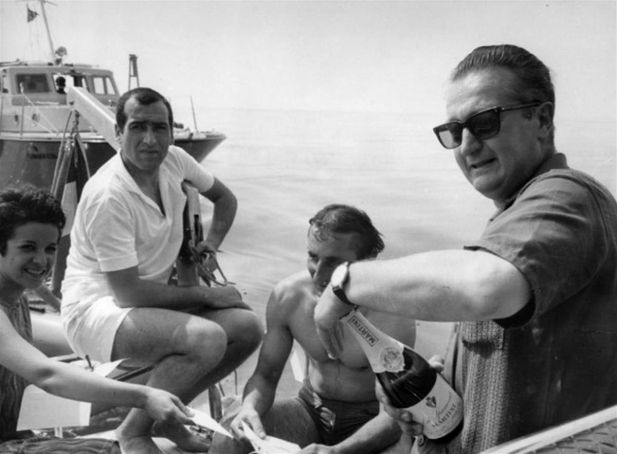The story of the Italian Republic's only act of invasion.
Italian director Sydney Sibilia's latest film, The Incredible Story of Rose Island, is the story of the Republic of Roses, an independent state founded by Giorgio Rosa, on a concrete platform he built by himself in international waters. And, it is also the story of the Italian Republic's only act of invasion.
The Incredible Story of Rose Island begins with the finale, in Strasbourg in November 1968, when Giorgio Rosa goes to the European Court, which regulates disputes between states, to present his case. There he explains what happened to him, and so the audience also goes over the events in flashback.

In the quintessential year of rebellion, in Bologna, Italy, Rosa (Elio Germano) was a recently graduated engineer with a great interest in construction and independence, combined with little regard for the law. Rosa had the idea of a state of its own, a place to be free. He has the idea to build his own island, finding a point outside national Italian territory, in the middle of the sea off the coast of Rimini, a beachside town in Italy.
Set against the backdrop of the antiquated inner- workings of the Italian state, and the conflict it created against the most concrete experiment of a libertarian utopia in history, the film succeeds in telling the tale of a man who was able to do what no one thought possible (build something himself in international waters).
However, while the movie uses humor and a fantastic soundtrack to emphasize the clash between authority, and Giorgio Rosa’s desire for autonomy, it is important to remember the historical significance of one man’s fight against the Italian government. In honor of the memory of the actual Rose Island, here are three things the Netflix film got wrong, for the sake of historical accuracy.
1. The work on the Isle of Roses lasted a decade
In the film, Giorgio Rosa and his friend Maurizio build Rose Island in a short time. However, the engineer actually took a full ten years to realize his project. Work began in 1958 and was completed in 1967. During this time there was no shortage of problems and friction. For example, in 1962 the Italian authorities ordered the builders to remove all obstacles to navigation.
Giorgio did not lose heart and, after contacting the Port Authorities of Rimini, Ravenna and Pesaro, purchased space on the wharf, obtained diesel fuel supplies and permission to build the structure at the Cantieri Navali, and published a notice to mariners warning of the presence of structures. He managed to restart construction in 1964.
In 1966, the Rimini Harbour Master's Office once again ordered construction to cease, which lacked authorization, because of the concession of the area to Eni (Italy’s energy company). But the construction of the island continued: a reinforced concrete platform of 400 square meters and walls were put in place.
In addition, a landing point called Porto Verde was created, equipped with a dock and access stairs. The initial plan was to create five floors, but in the end only one was completed. In the following months, a refined drilling technique brought a fresh water supply to whole island.
The island was opened to the public on August 20, 1967 and immediately became a tourist attraction for thousands of people, while the following year it was declared an independent state with Giorgio Rosa as its head.
2. The elimination of Rose Island

The film romanticizes the events of the end of the island, with the story of Rosa defending his island even at the threat of warning shots from the Italian Navy. In reality, the island did not collapse with the first round of explosives. The Navy, acting on orders from the Italian government, tried again two days after the first attempt, but with more powerful explosives, and managed to deform the structure of the platform.
The Rose Island finally collapsed on 26 February under a strong wind. In the following months the Island was dismantled and eliminated completely. In 2009 some remains of the structure and walls of the island were found on the seabed. An original brick is now preserved by Lorenzo, the son of Giorgio and Gabriella Rosa.
3. The love story between Giorgio Rosa and Gabriella

In the film, Giorgio Rosa struggles to win the love of Gabriella (Matilda De Angelis). In reality, Giorgio and Gabriella were already married when Rose Island was built, and they did everything possible to keep it alive together. They never left each other and had a son, Lorenzo.
Giorgio Rosa passed away in 2017, at the age of 92. After the demolition of Rose Island, he established himself as an engineer and professor.
In a way, accordinag to the Nteflix movie directorSydney Sibilia, Giorgio Rosa changed the world. A major international law on extra- territorial confines was altered after Giorgio's case, which resulted in expanding the physical boundaries of a government's legal ability to exercise authority.
General Info
View on Map
Rose Island: a true and incredible Italian story
5HJX+2X, 47900 Rimini, Province of Rimini, Italy




















